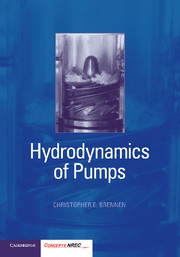Book contents
- Frontmatter
- Contents
- Preface
- Nomenclature
- 1 Introduction
- 2 Basic Principles
- 3 Two-Dimensional Performance Analysis
- 4 Other Flow Features
- 5 Cavitation Parameters and Inception
- 6 Bubble Dynamics, Damage and Noise
- 7 Cavitation and Pump Performance
- 8 Pump Vibration
- 9 Unsteady Flow in Hydraulic Systems
- 10 Radial and Rotordynamic Forces
- Bibliography
- Index
7 - Cavitation and Pump Performance
Published online by Cambridge University Press: 04 February 2011
- Frontmatter
- Contents
- Preface
- Nomenclature
- 1 Introduction
- 2 Basic Principles
- 3 Two-Dimensional Performance Analysis
- 4 Other Flow Features
- 5 Cavitation Parameters and Inception
- 6 Bubble Dynamics, Damage and Noise
- 7 Cavitation and Pump Performance
- 8 Pump Vibration
- 9 Unsteady Flow in Hydraulic Systems
- 10 Radial and Rotordynamic Forces
- Bibliography
- Index
Summary
Introduction
In this chapter we turn our attention to another of the deleterious consequences of cavitation, namely its effect upon the steady state hydraulic performance of a pump. In the next section we present several examples of the effect of cavitation on conventional pumps. This is followed by a discussion of the performance and design of cavitating inducers which are devices added to conventional pumps for the purpose of improving the cavitation performance. Subsequent sections deal with the analytical methods available for the evaluation of cavitation performance and with the thermodynamic effects of the phase change process on that performance.
Typical Pump Performance Data
A typical non-cavitating performance characteristic for a centrifugal pump is shown in figure 7.1 for the Impeller X/Volute A combination (Chamieh 1983) described in section 2.8. The design flow coefficient for this pump is φ2 = 0.092 but we note that it performs reasonably well down to about 30% of this design flow. This flexibility is characteristic of centrifugal pumps. Data is presented for three different shaft speeds, namely 600, 800, and 1200 rpm; since these agree closely we can conclude that there is no perceptible effect of Reynolds number for this range of speeds. The effect of a different volute is also illustrated by the data for Volute B which is a circular volute of circumferentially uniform area.
- Type
- Chapter
- Information
- Hydrodynamics of Pumps , pp. 96 - 136Publisher: Cambridge University PressPrint publication year: 2011

